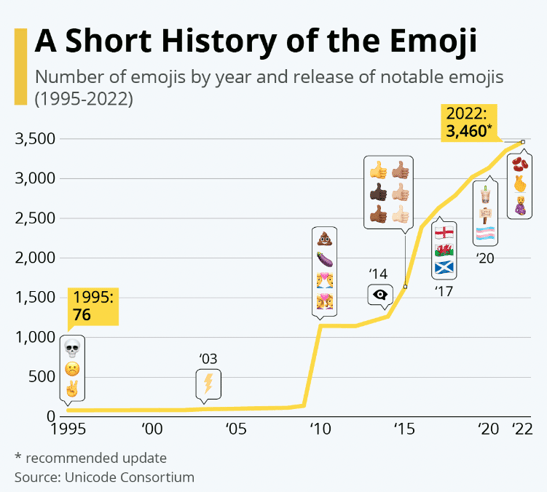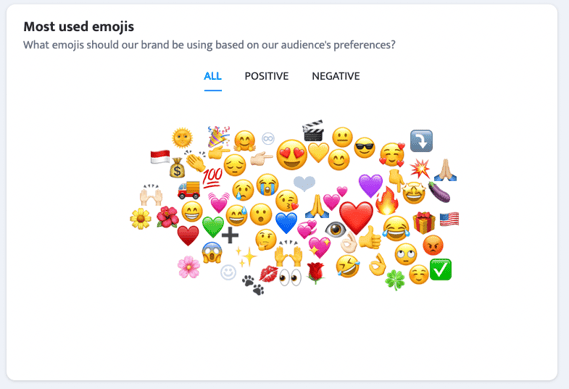.jpg?width=300&name=featured_emoji%20(1).jpg)
5 Reasons Why Your Brand Should Use Emojis in Social Media
Emojis have only been around since the late 1990s, but they quickly changed the way we communicate. Initially embraced mainly by teenagers and viewed skeptically in professional environments, emojis have come a long way. They even earned the prestigious title of Word of the Year by Oxford Dictionaries in 2015.
So, what should brands know about emojis, how should they interpret them, and why even use them? Keep reading to find out!
History of the emojis
The origin of emojis can be traced back to 1999, when a Japanese mobile service provider introduced 176 pixelated images to enrich text messaging. As smartphones gained popularity and communication platforms expanded, emojis spread globally.
Today, the official body governing international emoji standards, the Unicode Consortium, lists 3,664 emojis currently available. This collection continues to expand as new emojis are requested from the public.
- 📊 More than 90% of the world's online population uses emojis for digital communication
- 📈 More than 700M emojis are used in Facebook posts every day
- 💬 Using emojis in Instagram posts can boost engagement rate by 48%
- 🆙 Based on 7 billion tweets over 10 years, emoji use has never been higher
- 👁 There are +46 secret TikTok emojis [built into the app and hidden in plain sight]

Five reasons why you should communicate with emojis
Comments and messages encompass a variety of language modalities, including emojis, gifs, images, hashtags, and more. These elements play a significant role in expressing sentiment or giving meaning to words or entire sentences. It's essential for businesses to communicate with emojis thoughtfully, considering their target audience and cultural implications.
1. Emojis add context and boost message impact
In the realm of communication, words only account for about 7% of the message. The remaining 93% includes crucial elements like tone, gestures, and facial expressions. This brings us to Mehrabian's 7-38-55% communication rule, which reveals that written communication only captures a fraction of the entire message. That's where emojis and text formatting come in, allowing us to express emotions.
Emojis are particularly helpful in navigating sarcasm. For example, consider this comment: "The movie was so amazing - it was definitely worth those two hours of my time!"
At first glance, it seems like the user thoroughly enjoyed the movie and expressed gratitude for the recommendation. However, the inclusion of emojis such as "💩😂 🤮🤦😩😅" could suggest otherwise.
Fun fact: Out of all the existent emojis, only 22% are potentially harmful, while 78% are either always positive or non-harmful.
For example, hearts (excluding 💔) and laughing emojis generally convey positivity, whereas crying emojis, 👎,💩, 🗑️, and 🤮 emojis tend to be negative. However, emojis may also be used unexpectedly. For example, laughing emojis can be used negatively, especially to convey sarcasm. Additionally, certain fruit and vegetable emojis can carry sexual connotations.
2. Emojis make your brand sound more human and enhance emotional connection
Humans have an innate need for connection, belonging, and community. This desire to understand and be understood is even more important on social media, where interactions lack in-person cues. Emojis play a crucial role in bridging this gap by conveying emotions and nuances that text cannot.
According to a recent Adobe survey, 73% of US emoji users perceive people who use emojis as friendlier, funnier, and cooler. This positive perception extends to work environments, especially due to remote work. The survey revealed that 68% of respondents appreciate the use of emojis at work. They found that emojis help to quickly share ideas (79%), make team decision-making more efficient (62%), and boost creativity (58%).
3. Emojis create a common language for the world and foster empathy
Emojis are an example of “iconic signs”, a term coined by the father of linguistics Ferdinand de Saussure. Iconic signs look similar to the exact objects they represent and thus are often better descriptions of the objects than words. Emojis can even be considered a universal language based on this.
Besides creating a common language for the world, emojis can also foster empathy. According to an Adobe survey, 88% of U.S. users are more likely to feel empathetic toward someone if they use an emoji.
Fun fact: Did you know that these are the top 10
most popular emojis in current use?
😂 Face with Tears of Joy
❤️ Red Heart
🤣 Rolling on the Floor Laughing
👍 Thumbs Up
😭 Loudly Crying Face
🙏 Folded Hands
😘 Face Blowing a Kiss
🥰 Smiling Face with Hearts
😍 Smiling Face with Heart-Eyes
😊 Smiling Face with Smiling Eyes
4. Emojis reflect our times, influence how people think, and help you stay relevant
While users around the world may agree on the usage of some emojis, other emojis have stirred up debates. Take the example of the DNA emoji 🧬, which caused controversy among scientists due to its inaccurate left-handed twist.
Another debated emoji is the Green Salad emoji, which originally featured an egg. Google removed the egg to accommodate vegans, drawing disappointment from the British Egg Industry Council.
Emojis have also made strides in diversity and inclusion. The introduction of different skin tones in 2015 paved the way for representation, followed by updates in 2020/2021 that included non-binary options and interracial couples.
5. Emojis increase engagement and trustworthiness of online reviews
When emojis are used in a message, this generates empathy on the receiver’s end. Does this empathy also foster more trust in the sender of the message, increasing the message’s persuasiveness? Scientific investigations suggest that this tends to be the case, especially for negative comments and reviews.
The negativity bias theory says people value negative information more than positive information when making decisions. In studies where identical reviews were presented to participants with and without emojis, the negative reviews that had emojis were considered more useful and credible (Qiu, Wang, Pang & Jiang, 2016; Manganari & Dimara, 2017)
Furthermore, the inclusion of emojis in online reviews adds a personal touch and authenticity. Customers perceive reviews with emojis as more genuine and relatable. Emojis can humanize the feedback and make it feel like a conversation rather than a sterile text. This, in turn, boosts trust in the reviews and influences the decision-making process of potential customers.
What emojis should your brand use based on your audience's preferences?
When it comes to using emojis in social media marketing, understanding your audience's preferences is key. Here are some strategies to determine which emojis will best suit your audience:
- Understand the demographics of your target audience: Different age groups and cultures may have varying emoji preferences. For example, younger demographics might favor trendy and playful emojis, while older audiences might prefer more traditional and straightforward options.
- Observe social media language: Pay attention to how your audience engages with emojis in their comments, messages, and posts. Look for recurring emojis, patterns, or trends that emerge in their communication.
- Stay true to your brand's voice: While it's important to consider your audience's preferences, it's equally vital to maintain consistency with your brand's values and personality.
- Be culturally sensitive: Emojis can have different meanings and interpretations across cultures. Avoid using emojis that could be misinterpreted or considered offensive in a specific culture.
BrandBastion Lite can help you find these emojis easily:
 Our AI-powered platform monitors conversations across your social channels to show you what people are talking about, including the most popular emojis. Start a free trial now and navigate to the Analyze tab > Overview > Topics.
Our AI-powered platform monitors conversations across your social channels to show you what people are talking about, including the most popular emojis. Start a free trial now and navigate to the Analyze tab > Overview > Topics.
In summary...
Emojis changed communication since the late 1990s. They became a global language used by over 90% of people online. They aren't just whimsical symbols; they are powerful tools that can elevate your brand's social media posts.
By embracing emojis in your marketing strategy, you can add depth and authenticity to your communication. So go ahead, use emojis creatively, and watch your brand's engagement and influence soar to new heights! 🚀